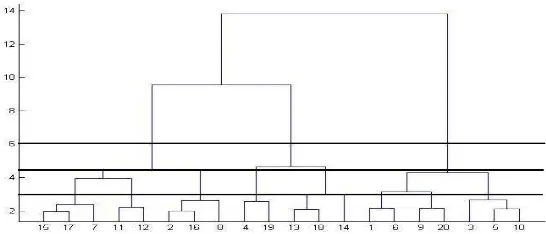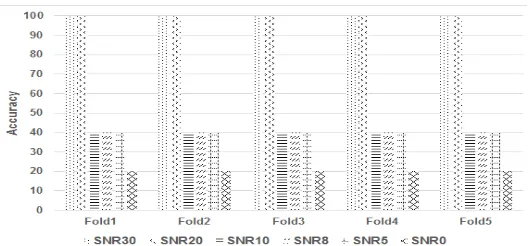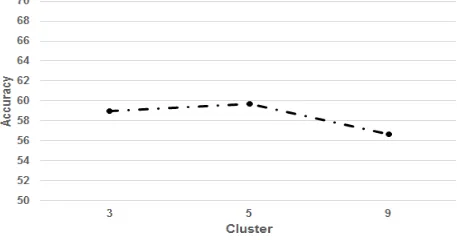DOI: 10.12928/TELKOMNIKA.v15i1.4656 322
Modeling Text Independent Speaker Identification with
Vector Quantization
Syeiva Nurul Desylvia*1, Agus Buono2, Bib Paruhum Silalahi3 1,2
Department of Computer Science, Bogor Agricultural University, Indonesia 3Department of Mathematic, Bogor Agricultural University, Indonesia
Corresponding author, email: [email protected]*1, [email protected], [email protected]
Abstract
Speaker identification is one of the most important technologies nowadays. Many fields such as bioinformatics and security are using speaker identification. Also, almost all electronic devices are using this technology too. Based on number of text, speaker identification divided into text dependent and text independent. On many fields, text independent is mostly used because number of text is unlimited. So, text independent is generally more challenging than text dependent. In this research, speaker identification text independent with Indonesian speaker data was modelled with Vector Quantization (VQ). In this research VQ with K-Means initialization was used. K-Means clustering also was used to initialize mean and
Keywords: speaker identification, text independent, vector quantization, Indonesian speaker, K-Means clustering
Copyright © 2017 Universitas Ahmad Dahlan. All rights reserved.
1. Introduction
Nowadays, speech based technology has been widely used, such as speech based password at smartphone and PC/laptop to biometric and security applications. Those technologies are example of speaker recognition implementation. One of speech recognition branch is speaker identification which is to identify new speaker based on developed speaker model without known hypothesis that the new speaker is. Then, speaker recognition is divided into text dependent and text independent. Text independent system only depends on vocal tract characteristic from each speaker and there is no assumption about speech context. Text dependent speaker recognition does recognition based on defined words [1]. The possibility of research based on speaker identification is still wide because this technology is still developing rapidly. The example of those research including modification of current method and finding new method.
Template based method such as Vector Quantization (VQ) has been widely developed in many research. For example, [7] modified VQ at similarity search between template training vectors with testing vectors.
According to mentioned research, VQ is capable to be used for speaker recognition system. In this research, VQ will be used to model Indonesian language for text independent speaker identification.
The aim of this research is for modeling Indonesian language data VQ. To get expected result, stages will be done are data collection, preprocessing, dividing training and testing data, feature extraction, modeling data with VQ, testing, and evaluation.
2. Research Method
Figure 1 shows the method of this research. Input model is a speech data and output model is recognized speaker id according to testing data. This input output process showed in Figure 2.
Figure 1. Research Method
2.1. Data Acquisition
Data used in this research are speech data consisting of 985 words. The data recorded using PC head phone at Computational Intelligence laboratory, Computer Science IPB.
Speakers are 3 women and 2 men with age range about 25 to 35 years old. The speakers’
condition is healthy and there is no cover when recording. Application used is Audacity 2.1.2.
Figure 2. System Input and Output
2.2. Preprocessing
This phase divided into 2 steps which are normalization and silence removal. At normalization, speech data normalized at range -1 to 1. It is to reduce mic effect in recording process. Normalization method used is Min-max Normalization according to this formula [8]:
i: New value according to resulted normalization.
The objective of silence removal is to get the data that is ready to process without any silence. Silence removal conducted using Audacity 2.1.2.
Table 1. Data Duration Before and After Preprocessing Speaker Before Preprocessing (Minutes) After Preprocessing (Minutes)
1 07.55 05.30
In this research, each speech data for each speaker divided into 10 segments. Next, K-Fold Cross Validation (CV) is used to measure model performance based on some sample data partition randomly. In this research, 5-Fold Cross Validation is used.
2.4. Feature Extraction
Prior to feature extraction phase, data integration is carried out. Then, Frequency Cepstral Coefficients (MFCC) is implemented for feature extraction. The number of coefficient is 13 cepstral coefficients.
2.5. Training and Testing
VQ model or centroid model is one of the simplest speaker model text independent. In the application of speech recognition, for example testing data feature vector is symbolized by
and reference vector symbolized by with D is average vector R. But, for computation reason, usually the number of vector is reduced using clustering method such as K-Means. The result of that clustering method is called as codebook (Kinnunen 2010). In this research, the value of k at K-Means algorithm is defined by Hierarchical Agglomerative Clustering (Ward).
2.6. Evaluation
In this phase, accuracy calculation is carried out to measure overall system performance. Furthermore, Signal to Noise Ratio (SNR) is used to measure model performance with noisy data. In this research, SNR value applied are 30, 20, 10, 8, 5, and 0.
3. Results and Analysis 3.1. Data Acquisition
3.2. Pre-processing
The first phase in pre-processing is normalization according to equation (1). The next phase is silence removal using Audacity 2.1.2. The result of this phase is also presented at Table 1.
3.3. Data Partition
The result of 5-Fold cross validation is 40 training data vector and 10 testing data vector for each fold.
Figure 3. Dendrogram to Define the Value of k
3.4. Feature Extraction
The result of this phase is a feature vector matrix which has 13 feature coefficients as defined.
3.5. Training and Testing
In this phase, VQ function is called as much as the number of fold defined. Based on resulted Dendrogram at Figure 3, the number of k used are 3, 5, and 9.
Figure 4 presents VQ result without any noise addition to data. In this scenario, VQ gets 100% accuracy. Next, Figure 5 shows VQ result with noise addition at k equals to 3. VQ has 100% accuracy at SNR 30 but decreasing at highest SNR. At SNR 20, VQ accuracy is 96% then 40% at SNR 10, 8, and 5. VQ obtains accuracy of 38% at SNR 0. Based on Figure 6 that presents VQ with k equals to 5, VQ recognizes all testing data with accuracy of 100% at SNR 30. At SNR 20, resulted accuracy is 92% then 52% at SNR 10. Accuracy at SNR 8, 5, and 0 are 42%, 40%, and 32%. Figure 7 presents testing result with k equals to 9. VQ acquires the best accuracy (100%) at SNR 30 and 20. Then, accuracy decreases at SNR 10, 8, 5, and 0 to be 40%, 40%, 40%, and 20%. Based on resulted accuracy, VQ model is capable to recognize testing data for each speaker well at SNR 30 and 20 but after that, the model performance decreases in conjunction with higher noise ratio.
VQ obtains better average accuracy at k equals to 5 which is 59.67% then 59% and 56.67% when k equals to 3 and 9.
Figure 5. VQ Testing Result with k Equals to 3
Figure 6. VQ Testing Result with k Equals to 5
Figure 7. VQ Testing Result with k Equals to 9
3.6. Evaluation
Based on testing result, VQ accuracy is 59% at k equals to 3. Furthermore, VQ at k equals to 5 obtains 59.67% and VQ gets 56.67% at k equals to 9. It can be concluded that althought VQ still needs more improvement; VQ can be used to model Indonesian language for text independent speaker identification. Another insight is at Figure 8 which shows VQ’s average accuracy based on the value of k. It can be observed that VQ accuracy is the best when k equals to 5. The resulted accuracy of VQ at k equals to 3, 5, and 9 consecutively are 59%, 59.67%, and 56.67%.
Figure 8. VQ Testing Result based on k Values
4. Conclusion
Based on training and testing, Vector Quantization (VQ) best accuracy is 59.67% at speaker identification text identification model in Indonesian Language. This is because VQ only model each speaker only by their clustering mean.
VQ still needs improvement. For future research, the application of optimization methods such as Maximum Likelihood, Genetic Algorithm, or Particle Swarm Optimization can be developed.
References
[1] Beigi H. Fundamentals of Speaker Recognition. New York (US): Springer. 2011: 3-5.
[2] Najkar S, Razzazi F, Sameti H. A novel approach to HMM-based speech recognition systems using particle swarm optimization. Math Comput Model. 2010; 52(2010): 1910-1920.
[3] Daqrouq K. Wavelet entropy and neural network for text-independent speaker identification. Eng Appl Artif Intel. 2011; 24(2011): 796-802.
[4] Daqrouq K, Tutunji TA. Speaker identification using vowels features through a combined method of formants, wavelets, and neural network classifiers. Applied Soft Computing. 2015; 27(2015): 231-239.
[5] Daqrouq K, Al Azzawi K. Average framing linear prediction coding with wavelet transform for text-independent speaker identification system. Computers and Electrical Engineering. 2012; 38(2012): 1467-1479.
[6] Nemati S, Basiri ME. Text-independent speaker verification using ant colony optimization-based selected features. Expert Syst Appl. 2011; 38(2011): 620-630.
[7] Permana I, Buono A, Silalahi BP. Similarity measurement for speaker identification using frequency of vector pairs. Telkomnika. 2014; 12(8): 6205-6210.




